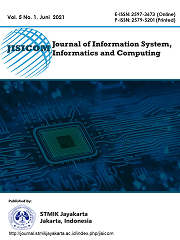ANALISIS DAN RANCANGAN MANAJEMEN PROSES BISNIS UNTUK LAYANAN PELANGGAN DI PT. PGAS TELEKOMUNIKASI NUSANTARA
Abstract
Business Process Management for corporate customer service is a comprehensive series of activities to define the types of products and services that will be the main needs of customers, so that the quality of service results can be planned and measured. Business process design is a framework for a core process that develops from a short-term and long-term business strategy, so that the business strategy will determine the pillars of the business that will be carried out. Serving the needs of customers and interested parties will be the main focus of a business process that will be carried out within the organization. The application of business process management is a method for identifying and evaluating a company's business and for finding out the current condition of the company in developing improvement programs that can be done through a descriptive process. The output and application of business process management are in the form of increasing the efficiency and productivity of the company in terms of cost and time as well as improving the quality of products and services produced, as well as mitigating business risks that may occur. Data collection methods, analysis methods, development methods, design design methods and testing methods are research methods that are used systematically so that it includes several activities for gradual improvement of the work process from previous conditions and increasing system reliability to obtain facts or principles from knowledge with how to issue register and perform root cause analysis with several impact assessments by quantitative analysis, heuristic design, simulation, flow analysis, pareto analysis and pick chart, queue, up to a systematic redesign to the process.
Downloads
References
[2] K. Schwab, “The Fourth Industrial Revolution: What It Means and How to Respond,” 2017.
[3] P. Diawati, Inovasi sebagai Inti Proses Bisnis : Implementasi pada Keinovasian Wirausaha Industri Kecil. Bandung: Manggu Makmur Tanjung Lestari, 2017.
[4] M. Wibowo, Efisiensi Perusahan melalui Penerapan Manajemen Proses Bisnis. Jakarta: Grasindo, 2014.
[5] J. Tidd and J. Beasant, Managing Innovation:Integrating Technological Market and Organizational Change. United Kingdom: John Wiley and Sons, 2014.
[6] Kamus Besar Bahasa Indonesia, “Definisi Analisis.” kbbi.kemdikbud.go.id.
[7] S. Riyanarto, A. H. Fauzan, A. N. Nurlaili, D. Rahmawati, K. R. Sungkono, and Y. A. Effendy, Manajeman Proses Bisnis , Model dan Simulasi (Dasar BPM Certification di www.bpminstitute.org), Edisi Pert. Surabaya: ITS Tekno Sains, 2017.
[8] M. Weske, Business Process Management. 2015.
[9] M. Hammer, “What is Business Process Management,” 2015.
[10] J. Vom Brocke, T. Schmiedel, J. Recker, P. Trkman, W. Mertens, and S. Viaene, “Ten principles of good business process management,” Bus. Process Manag. J., vol. 20, no. 4, pp. 530–548, 2014, doi: 10.1108/BPMJ-06-2013-0074.
[11] M. Von Rosing, H. Von Scheel, and A. W. Scheer, The Complete Business Process Handbook: Body of Knowledge from Process Modeling to BPM, vol. 1. 2014.
[12] R. K. L. Ko, S. S. G. Lee, and E. W. Lee, “Business process management (BPM) standards: A survey,” Bus. Process Manag. J., vol. 15, no. 5, pp. 744–791, 2009, doi: 10.1108/14637150910987937.
[13] M. Netjes, H. A. Reijers, and W. M. P. Van Der Aalst, “Supporting the BPM life-cycle with FileNet,” CEUR Workshop Proc., vol. 364, pp. 135–146, 2006.
[14] A. Hallerbach, T. Bauer, and M. Reichert, “Managing process variants in the process life cycle,” ICEIS 2008 - Proc. 10th Int. Conf. Enterp. Inf. Syst., vol. 2 ISAS, pp. 154–161, 2008, doi: 10.5220/0001685001540161.
[15] U. Kannengiesser, “Subsuming the BPM life cycle in an ontological framework of designing,” Lect. Notes Bus. Inf. Process., vol. 10 LNBIP, pp. 31–45, 2008, doi: 10.1007/978-3-540-68644-6_3.
[16] M. Zur Muehlen and D. T. Y. Ho, “Risk management in the BPM lifecycle,” Lect. Notes Comput. Sci. (including Subser. Lect. Notes Artif. Intell. Lect. Notes Bioinformatics), vol. 3812 LNCS, no. September 2005, pp. 454–466, 2005, doi: 10.1007/11678564_42.
[17] M. Dumas, M. La Rosa, J. Mendling, and H. A. Reijers, “Fundamentals of Business Process Management,” 2013.
[18] R. Dijkman, I. Vanderfeesten, and H. a Reijers, “The Road to a Business Process Architecture: An Overview of Approaches and their Use,” Architecture, vol. 350, no. July, pp. 1–17, 2011, [Online]. Available: http://cms.ieis.tue.nl/Beta/Files/WorkingPapers/wp_350.pdf.
[19] E. Mahendrawathy, Business Process Management , Konsep dan Implementasi, I, 1st Pub. Yogyakarta: ANDI OFFSET, 2018.
[20] S. Huda, R. Sarno, and T. Ahmad, “Increasing Accuracy of Process-based Fraud Detection Using a Behavior Model,” Int. J. Softw. Eng. Its Appl., pp. 175–188, 2016.
[21] A. J. M. M. Weijters, W. M. . Van der Aalst, and A. K. A. De Medeiros, “Process Mining with the Heuristics Miner-algorithm,” Tech. Univ. Eindhoven.
[22] D. Rahmawati, S. Riyanarto, and M. . Yaqin, “Fraud detection on event logs of goods and services procurement business process using Heuristics Miner algorithm,” 2016.
[23] M. Dumas, M. La Rosa, J. Mendling, and E. H. A. Reijers, “Fundamentals of Business Process Management,” 2018.

This work is licensed under a Creative Commons Attribution 4.0 International License.























.png)
.png)


